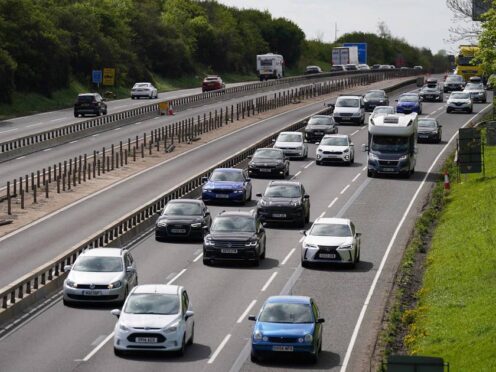Delays on England’s major roads exceeded pre-pandemic levels last year despite a reduction in traffic, Department for Transport (DfT) figures show.
The RAC described the data as “very concerning” and urged the Government to provide “sufficient funds” to tackle the causes of congestion.
DfT statistics show the average delay on England’s strategic road network (SRN) – motorways and major A-roads – last year was 10.5 seconds per vehicle per mile (spvpm).
That is up from 9.3 seconds in 2022 and 9.5 seconds in 2019, before the coronavirus crisis.
The average speed on the SRN in 2023 was 57.0mph, down from 58.1mph during the previous year and 58.0mph in 2019.
Separate DfT figures show the amount of traffic on Britain’s motorways in the year to the end of September was 1.4% below 2019 levels, with traffic on A-roads down 3.5%.
RAC head of policy Simon Williams said: “It’s very concerning to see delays on our most important roads increasing to above pre-pandemic levels and average speeds dropping.
“With more people than ever working from home at least part of the week and no growth in the number of cars on the road since then, we’re struggling to see what the cause can be other than roadworks.
“We’re aware safety concerns relating to the all-lane-running smart motorway experiment have required lots of retrofitting of emergency refuge areas which has limited capacity on these key routes.
“While this is necessary, it is frustrating as it could easily have been avoided had the distance between them not been quietly reduced as more schemes were rolled out over the years.
“Given today’s disappointing findings, it’s more important than ever that National Highways, which is responsible for the strategic road network, is given sufficient funds in the next five-year road investment settlement to tackle these issues head on.
“This is just about to be agreed so time is of the essence.”
A spokesperson for National Highways said: “We know delays are frustrating but a number of factors contribute to slower moving traffic.
“The make-up of vehicles on the road is changing with more HGVs and larger vehicles together with fewer cars. This brings average speeds down.
“Roadworks are only in place where it is absolutely necessary.
“Our programme of improvements will result in long term benefits for motorists – shorter and more reliable journeys as well as safer and smoother roads.
“This work will help boost the economy.”
A DfT spokesperson said: “This Government backs drivers, which is why we’re getting on with our plan to invest over £24bn into our roads to reduce congestion, improve road safety and grow the economy.
“As well as investing more into new and improved roads, we have a Plan for Drivers to slam the brakes on anti-driver measures and help keep our country moving.”
